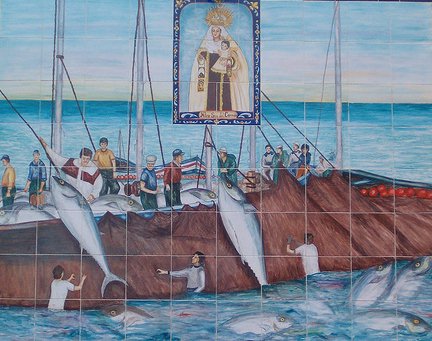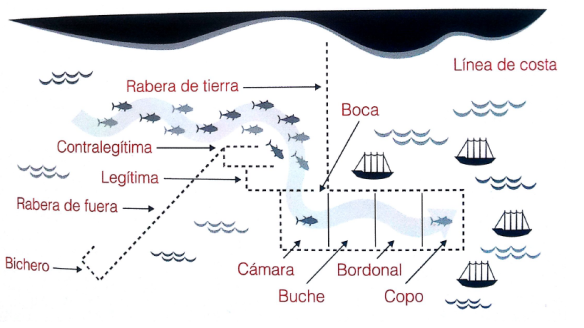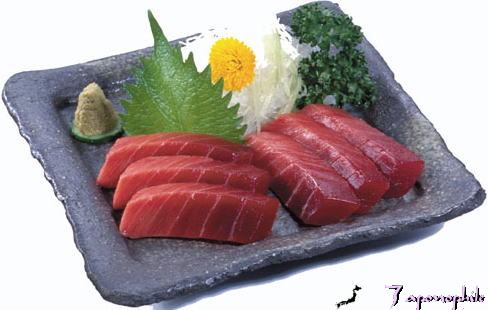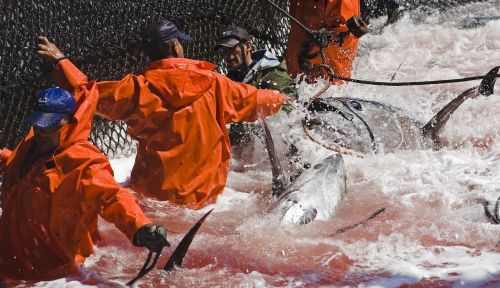 Every May, thousands of Atlantic bluefin tuna (atún rojo) swim through the Strait of Gibraltar at over 30 miles per hour to spawn in the Mediterranean. And for 3000 years fishermen have intercepted the large tuna in a fishing tradition called the almadraba in Andalusia and tonnara in Sicily.
Every May, thousands of Atlantic bluefin tuna (atún rojo) swim through the Strait of Gibraltar at over 30 miles per hour to spawn in the Mediterranean. And for 3000 years fishermen have intercepted the large tuna in a fishing tradition called the almadraba in Andalusia and tonnara in Sicily.
The almadraberos are often sons, grandsons, and great-grandsons of almadraberos, and feel a brotherhood with their fellow fishermen. They tend to be proud and tough, with a strong respect for history and the sea. They catch the tuna by putting out a maze of underwater nets that the bluefin swim through until they reach a final pool, el copo (diagram of a net, below).

Tuna swim east to the Mediterranean, going through various areas of the net until they reach the “copo,” where they are hoisted up out of the water.
Once the copo is filled, the fishermen circle their boats, working together to haul the huge net to just a few feet below the surface—the levantá del atún, or “raising of the tuna.” There are so many tuna jumping around in such a shallow space above the net that it creates the illusion that the water is boiling.
At this point the copejadores assume the treacherous task of jumping down into the net to hook and hoist the often 1000 pound-plus tuna, whose tails may be longer than the fishermen are tall, into the surrounding boats. Most copejadores have suffered many injuries over the years: broken knees, ankles, wrists, and noses. Some people call the practice slaughter, equating it to what they perceive as the savagery of bull fighting, while others perceive it as a noble tradition.
So what is endangering the historic almadraba tradition?
- Tuna have been overfished: there are half as many bluefin tuna in the Atlantic as there were 39 years ago. Some almadraberos report that they used to catch 1000 tuna a day, whereas now they are lucky to catch that amount in an entire season. The Atlantic Bluefin Tuna (thunnus thynnus) has been listed as endangered by the International Union for Conservation of Nature (IUCN’s “red list”) since 2011. But conservationists do not generally blame the almadraba for the species’ decline.
- Technology such as sonar tracking and huge vessels have brought stiff competition to traditional fishing methods such as the almadraba. Most research that I have seen in a web search equates overfishing to the larger, high-tech vessels and, ironically, to tuna farming—fishermen catch the young bluefin and then fatten them up in farms—rather than to traditional fishing methods such as almadraba.
- Do you like sushi? Japanese regard the cold-water Atlantic bluefin as the best fish in the world for sashimi, and atún rojo has turned the southern Spanish coast into a gastronomic destination. With prices for bluefin in Tokyo’s Tsukiji fish auction higher than ever (you’ll remember one fish sold for $1.8 million in 2013), demand has skyrocketed, which has resulted in the overfishing.

Video of the raising of the nets:
Video of how the almadraba nets work, and a bit of history and geography:
Video of the levantá del atún, right through to the filleting of the meat:
What traditions in your culture are in danger of extinction? How do we determine if it’s time to let go of a practice and flow with the changing times, or hang on to our ancestral practices? And, what makes a tradition a tradition?

